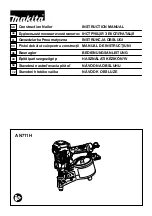
11
3. SAFETY DEVICES
The tool is provided with the following safety devices in order to
secure safety for pin driving work.
Mechanical Safety Device
This tool is equipped with a FULL SEQUENTIAL ACTUATION
MECHANISM. This tool will not discharge pins unless the Con-
tact Arm and Trigger have been activated simultaneously. The
pins are not discharged by neither simply pulling the Trigger nor
applying the Contact Arm to the pins driving object. The pins are
discharged only after applying the Contact Arm to the object and
pulling the Trigger.
•
Prior to using the tool, be sure to inspect it to see whether
the safety devices function properly. Do not use it if they
do not function properly.
Prior to using the tool, check whether the safety devices
function properly. With no pins loaded, install the Battery
and Fuel Cell to check.
∗
In the following cases, the safety devices are out of order.
Never use the tool.
1. An operating sound is emitted by simply pulling the trigger.
2. The tool starts dry-fire operation by simply applying the con-
tact arm to the object.
∗
A fan running sound is heard, this is OK.
If any abnormality is found, contact your nearest author-
ized distributor for inspection/repairing.
•
To avoid accidental firing or double firing, pull the trigger
rapidly and firmly.
4. HOW TO USE THE BATTERY
AND THE CHARGER
•
Be sure to charge Battery (Cat.#55583) for the tool with
Charger Base (Cat.#55618).
If charged with other charger, the Battery could fail to be
properly charged as well as get broken, ignited or gener-
ate the heat.
•
Do not put the Battery close to a fire.
•
Do not leave the Battery in the direct sunshine.
•
Do not charge or use the Battery in the wet condition with
a liquid such as water, sea water, milk, soft drink, soap
water.
•
Unplug the charger when it is not used.
•
Be sure to charge at 32°F (0°C) to 104°F (40°C) to avoid the
possibility of fire.
•
Do not give a strong shock such as hitting with a hammer,
stamping or dropping.
•
When the Battery is discharged or is not used for a long
period, remove it from the Charger.
•
After setting the Battery in the tool, do not hold it to carry
around.
PROPER USE OF BATTERY
1
Fully charge and discharge the Battery.
If you repeat charging the Battery while not fully discharged
more than half the capacity, the number of pins drivable by
each charging could decrease dramatically, shortening the
life of the Battery. It is recommended to use it until the LED
of the tool has been illuminated in red, running out of elec-
tricity.
2
Use two Batteries alternately.
To ensure the longer life of the Battery, it is recommended
to use two of them alternately, preparing a spare one.
Recycling the Nickel-Hydrogen Battery
The Battery for the tool uses nickel-hydrogen batteries which are
a precious recyclable resource. Once the Battery runs out of life,
take it to your nearest distributor without disposing of it.
•
In order to prevent short-circuiting, be sure to cover the
terminal block (metal section) of the Battery with the Pack
Cap (wind the insulating tape) for recycling.
<Battery cells in Battery Pack>
•
Nominal voltage: 1.2 V/piece
•
Quantity used in 1 pack: 5 pieces
Trigger
Contact Arm
CAUTION
WARNING
WARNING
CAUTION
WARNING
TI-C5-USA.book 11 ページ 2011年4月26日 火曜日 午後1時7分










































